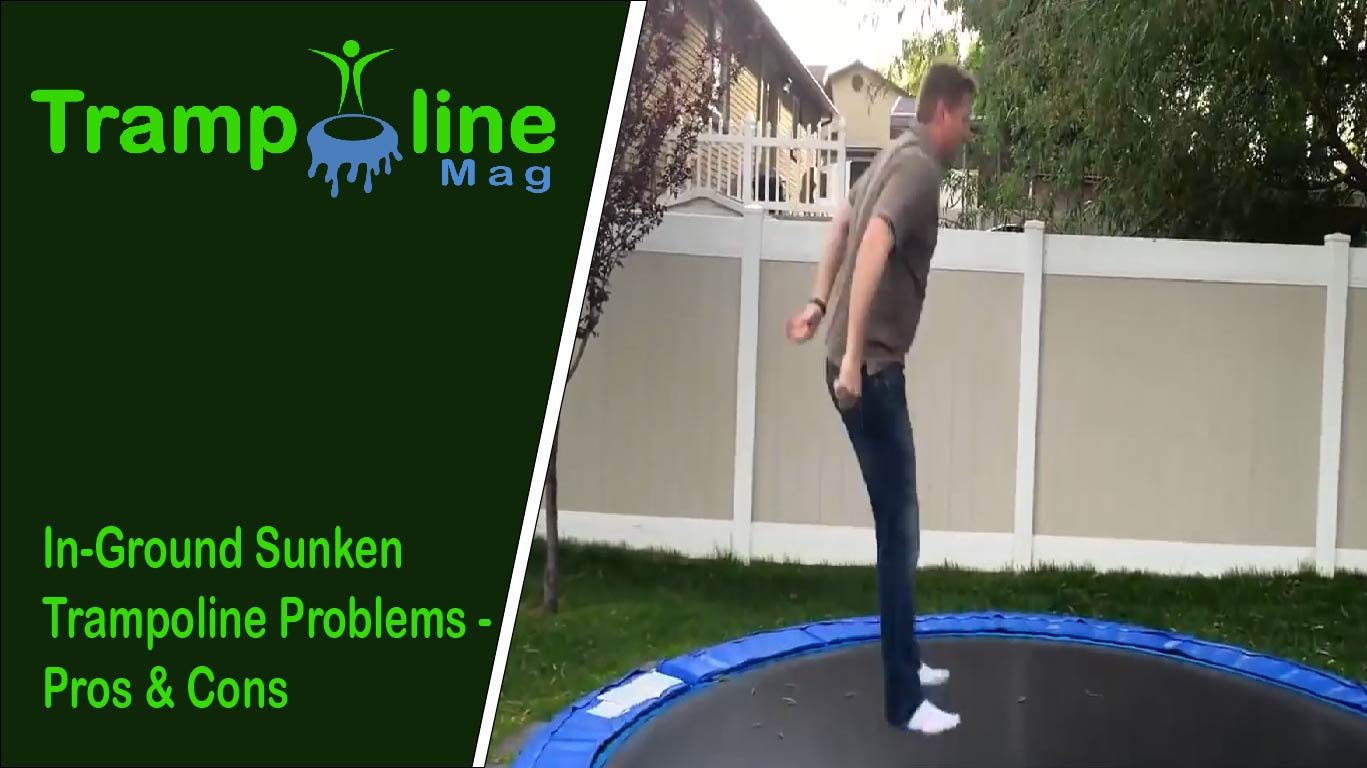Last Updated on May 4, 2023 by Charlie Nash
In-ground or sunken trampolines can be a great addition to any backyard, providing hours of fun and exercise for kids and adults alike. However, they also come with their own set of unique challenges and potential problems. From drainage issues to improper installation, soil settling, and more, sunken trampolines can pose a range of issues that can affect their safety, performance, and lifespan.
In this guide, we’ll explore some of the most common sunken trampoline problems and provide tips and solutions to help you keep your trampoline in top condition and ensure that it remains a safe and enjoyable backyard feature for years to come. Also, we’ll look at in-ground sunken trampoline problems & pros and help you decide if they’re right for you.
Pros & Cons of In-Ground Sunken Trampoline
There are a few pros and cons to having an in-ground sunken trampoline. Some people feel that they are much safer than traditional above-ground trampolines, while others believe they take away from the excitement and fun of bouncing on a trampoline. Here is a look at some of the pros and cons of owning an in-ground sunken trampoline.
Pros
- 1. Increased Safety – When a trampoline is installed in-ground, it creates a barrier between the jumper and the ground. This can help to prevent severe injuries in the event of a fall.
- 2. More aesthetically pleasing – In-ground trampolines can be installed flush with the ground, making them less of an eyesore in the yard.
- 3. Can be used in colder climates – If you live in an area with a lot of snowfall, an in-ground trampoline can be a great option. This is because the snow will not accumulate on the trampoline as it would if it were above ground.
Cons
- 1. Can be more expensive – In-ground trampolines can be slightly more expensive than traditional above-ground trampolines. Read our guide on how much an in-ground trampoline costs.
- 2. Might be harder to install – If you are unfamiliar with the installation, an in-ground trampoline might be a bit more challenging. But you can install an in-ground sunken trampoline on your own.
- 3. Can be more difficult to move – Once an in-ground trampoline is installed, it can be pretty challenging to move. This might be an issue if you need to change the location of the trampoline or if you decide to sell your home.
Overall, there are both pros and cons to owning an in-ground sunken trampoline. It is essential to weigh all of the factors before making a decision. If you are looking for a safe and aesthetically pleasing trampoline, an in-ground sunken trampoline might be the right choice for you. However, if you are on a budget or if you need to be able to move the trampoline quickly, an above-ground trampoline might be a better option.
In-Ground Sunken Trampoline Problems and Possible Fixes
If you’re in-ground sunken trampoline has any of the following problems, here are some possible fixes:
#1. Digging and Hole Measurement:
Digging a perfect hole is a very crucial step while setting up an in-ground sunken trampoline. Measurement needs to be accurate because if you dug a bigger hole there will be extra space left where your leg can get stuck or you can trip off and fall. If you dug a smaller hole your trampoline won’t fit in and that can cause damage to the trampoline. Also, how deep the hole should be? Because if it’s not deep enough it will touch the ground when you jump, causing injuries and damage to the mat.
Therefore, you must take all the measurements correctly before you start digging. If you are not sure you can always hire professional help.
#2. Installing the Retaining Wall
In-ground trampoline retaining wall kits are a great way to keep your trampoline in place and looking great. However, not everyone knows if they need one of these kits or not. If you want to install a retaining wall, you will have to take that into account too while digging the hole. It comes in form of parts so assembling it can be difficult for some.
An in-ground trampoline retaining wall kit is a specialized kit that helps you build a wall around your in-ground trampoline. This wall will keep the trampoline from moving and will also support the weight of the trampoline.
#3. Lifting the Trampoline
There are always some incidents where you’ll have to lift the trampoline. Something fell under i.e shoe or toy, or there is water filled in the hole. You will have to lift the trampoline and place it back safely. if you don’t put the trampoline back as it was or the trampoline isn’t balanced, that can cause damage to your trampoline. Lifting and placing it back can be difficult.
#4. The frame and springs rusting
This is a common problem with in-ground sunken trampolines. If the frame is made of metal, it will eventually rust. To prevent this, you can either purchase a trampoline frame made of rust-resistant material or regularly apply a rust inhibitor to the frame.
Rust is a common problem with in-ground sunken trampoline springs too. Again, to prevent this, you can either purchase rust-resistant springs, or you can regularly apply a rust inhibitor to the springs.
#5. Water Drainage:
Water drainage is one of the sunken trampoline problems. There will be times when an inground trampoline hole will be filled with water, and you will have to drain the water. You will need a pump and a pipe to dry the hole.
#6. Snakes:
In some areas, you might face the snake issue. The biggest safety risk with sunken trampolines is the fact that there may be snakes lurking underneath. It’s hard to have fun when constantly worried about being bitten by a snake. Read our guide on how to avoid in-ground trampoline snakes.
#7. The Mat is torn:
If the mat is starting to tear, it will need to be replaced. You can purchase a new mat from the same company that manufactured your trampoline or a universal mat that will fit most in-ground sunken trampolines.
#8. The Padding is worn:
If the padding around the edge of the trampoline is starting to wear, it will need to be replaced. You can purchase new padding from the same company that manufactured your trampoline or universal padding that will fit most in-ground sunken trampolines.
#9. The Net is ripped:
If the netting around the trampoline’s edge is starting to rip, it will need to be replaced. You can purchase a new net from the same company that manufactured your trampoline or a universal net that will fit most in-ground sunken trampolines.
You may need to contact the manufacturer for assistance if you have any other problems with your in-ground sunken trampoline that are not listed here.
In-Ground Sunken Trampolines Vs Above Ground Trampolines: Main Differences
#1. Frame:
The most significant difference between in-ground trampolines and above-ground trampolines is, of course, where they are installed. In-ground trampolines are set into the ground, while above-ground trampolines are elevated on a frame.
This has several implications. First, in-ground trampolines are much less likely to be moved or toppled over, making them a safer choice if you have small children. They’re also more aesthetically pleasing since they blend in with your landscaping.
#2. More Affordable:
Sunken trampoline cost is another big factor, and not only buying cost but sunken trampoline installation cost is high too. On the other hand, above-ground trampolines are more affordable and easier to set up. They’re also a good choice if you have limited space since they don’t take up as much room as in-ground trampolines.
#3. Safety:
When it comes to safety, both types of trampolines have their advantages and disadvantages. In-ground trampolines are less likely to be moved or toppled over, but they can be more dangerous if someone falls off since there’s nothing to break their fall. Above-ground trampolines are elevated, so they may be more likely to tip over, but they have safety nets that can help prevent serious injuries. Besides, you can always add a safety net to an in-ground trampoline.
#4. Ease of Maintenance:
If you plan on using your trampoline often, you’ll want to ensure it’s easy to maintain. In-ground trampolines require more maintenance than above-ground trampolines. They must be cleaned and maintained regularly to ensure they’re safe and functioning correctly.
Above-ground trampolines are easier to maintain because they have no moving parts. But you’ll still need to clean them occasionally. So if you’re planning on using your trampoline often, then an above-ground trampoline may be a better option.
Which one to choose?
Both trampolines are great for exercise and fun, so it comes down to personal preference when deciding which one to buy. If you’re worried about safety, an in-ground trampoline may be the better choice. On the other hand, an above-ground trampoline may be the way to go if you’re on a budget or have limited space. Whichever type you choose, follow the manufacturer’s instructions carefully and always supervise children when using the trampoline.
Also Read: 10 Best in-Gound Trampolines
FAQs
Conclusion
Each type has its advantages and disadvantages. Therefore, it is essential to understand the different types of trampolines before purchasing one.
In-ground sunken trampolines are a great way to get a good workout while still enjoying the outdoors. However, sunken trampoline problems are also there which can’t be ignored. Therefore, if you are interested in purchasing an in-ground sunken trampoline, it is vital to know the pros and cons to make an informed decision. Hopefully after reading this guide, everything is clear to you now.

I have been involved in the world of gymnastics for over 20 years! I started gymnastics when I was 5 years old and excelled in the sport eventually finding a way onto a team where I competed throughout high school and into college. With a passion for gymnastics and specifically Trampolines, I have decided to start a blog TrampolineMag, A trampoline magazine. I will share all the reviews, suggestions, and things I have learned about trampolines to make your trampoline experience fun and safe.

